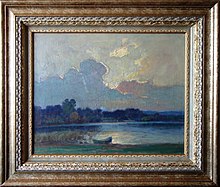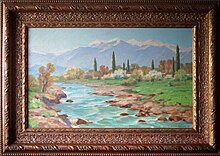Czeslaw Znamierowski
Czeslaw Viktorovich Znamierowski[Note 1] (23 May 1890 – 9 August 1977)[1][5] was a renowned Soviet Lithuanian painter, a member of the Artists' Union of the USSR,[6][7] known for his large artworks and love of nature.
Znamierowski combined these two passions to create some of the most notable paintings in the Soviet Union, earning a prestigious title of "Honorable Artist of LSSR" in 1965.
[19][20][21] Znamierowski was born in Zatišje, Ludza, in eastern Latvia, to a father who worked as a land-surveyor and a mother who was a music teacher.
His artworks were sold to museums, state institutions, galleries and private collection of Lithuania, Latvia, Poland, Russia (within the Soviet Bloc) as well as USA, Canada, Germany, Sweden, Spain, France (outside the Soviet Bloc) [8][24][25][26][23] It is very likely that his art was sold to many other countries:"His [Czeslaw Znamierowski's] works have been acquired by Lithuanian and foreign museums.
[2][3][8][27][24][30] After finishing high school Czeslaw collected all the money he could from selling his belongings and savings from various jobs to move to St. Petersburg.
[30] In Znamierowski's words: "I did not hesitate much, I sold my bicycle, with the cash collected I bought a railway ticket and in 1911 I found myself in a building at Moika…" [24] He was admitted into the "Society for the Encouragement of the Arts" located on Bolshaya Morskaya Street, not far from the Moika river.
In 1915 Znamierowski was accepted into St. Petersburg Academy of Arts, where teachings of Arkady Rylov (1870 – 1939) and works of Isaac Levitan (1860–1900) had a strong impact on the young artist.
There he took an active part in establishing of the Soviet government, and for some time had worked as a chairman of Proletariat Culture of Liucen region.
The reason why Znamierowski entered Vilnius University was not because he lacked knowledge or skills, but because he specifically wanted to study with Prof. Ferdynand Ruszczyc and Prof. Aleksander Szturman.
In 1933, again, his painting "Before Rain" won him a bronze medal in Zacheta National Gallery of Art exhibition called "Incentive".
[2][3][4][9][27] He continued to participate in exhibitions, social events and activities up until 1941 when the war broke out between Nazi Germany and the Soviet Union.
As a painter and a lover of flowers, Znamierowski redecorated the front yard into one of the most beautiful gardens in the city, attracting a lot of attention in the summer months.
After nearly 50 years of being a professional artist, Znamierowski had a substantial amount of small and large exhibitions in some of the most prominent national museums and galleries of the Soviet Union.
Znamierowski's artworks were exhibited in Riga, Ludza, Vilnius, Kraków, Warsaw, Moscow, St. Petersburg and many other cities in USSR.
[5][30][25] A large painting of Vilnius City created by Znamierowski took the center stage in the LSSR pavilion during the Exhibition of National Economic Achievements in Moscow.
[9][24] In 1933 at an exhibition called "Incentive" organized by the Zacheta National Gallery of Art C. Znamierowski won a bronze medal, once again for his painting "Before Rain".
Growing up in a small Latvian village, from early childhood he started to admire the changing colors of the seasons, the beauty of the fields, forests, lakes and rivers.
A favorite motif of the painter was a meandering river in the landscape, sometimes represented in a wide panoramic view, and sometimes in an intimate and romantic way.
[2][3][5][11][30][22] Over all the theme of the countryside takes a major part in his art and especially large panoramic paintings such as "Panorama of Vilnius City" and "The Green Lakes" in which the painter delicately reveals the beauty of nature.
"[2][11] Color and mood: Znamierowski was very sensitive to the beauty of nature, subtly grasping its specifics and feeling the rhythm of the composition.
He was one of the first artists who started to paint panoramic landscapes of Soviet Lithuania, which were intended to be used for decorating the interiors of public buildings.
You will find many of his paintings not only in the museums and institutions of Lithuania, but also in Latvia, USA, Sweden, Germany, as well as in private homes"[26] "Czeslaw Znamierowski's art covers thousands of landscapes, portraits, architectural sites.
His artworks were sold to museums, state institutions, galleries and private collection of Lithuania, Latvia, Poland, Russia (within Soviet Bloc) as well as USA, Canada, Germany, Sweden, Spain, France (outside Soviet Bloc) [8][24][25][26][23] It is very likely that his art was sold to many other countries:"His [Czeslaw Znamierowski's] works have been acquired by Lithuanian and foreign museums.
[8] "Within the long years of creative activity the artist produced more than 2000 paintings and sketches many of which were acquired by museums and art lovers.
[9][11] He had excellent work ethics, dedication and commitment to art which showed through over 3000 paintings that he created during his lifetime, many of which were of a very large panoramic size.
[4] On the outside, Znamierowski was very much a public figure, he performed in theater, participated in exhibitions, gave interviews and was a published art critic.
Roses, asters, peonies, orchids, dahlias and dozens of other sorts of flowers were inseparable part of the painter's home surroundings in Antakalnis.
He used to say that when in his childhood he saw the hideousness of drunken people, he – a man inseparably connected with a beauty – decisively discerned this aspect of ugliness.
"[4][32] Due to his intentional and unintentional multiculturalism, Znamierowski is considered a national artist of four countries – Latvia, Lithuania, Poland and Russia.
Znamierowski learned, read, wrote, and spoke fluent Lithuanian, but above that, he accepted Lithuania, and especially Vilnius (capital) as his home.













